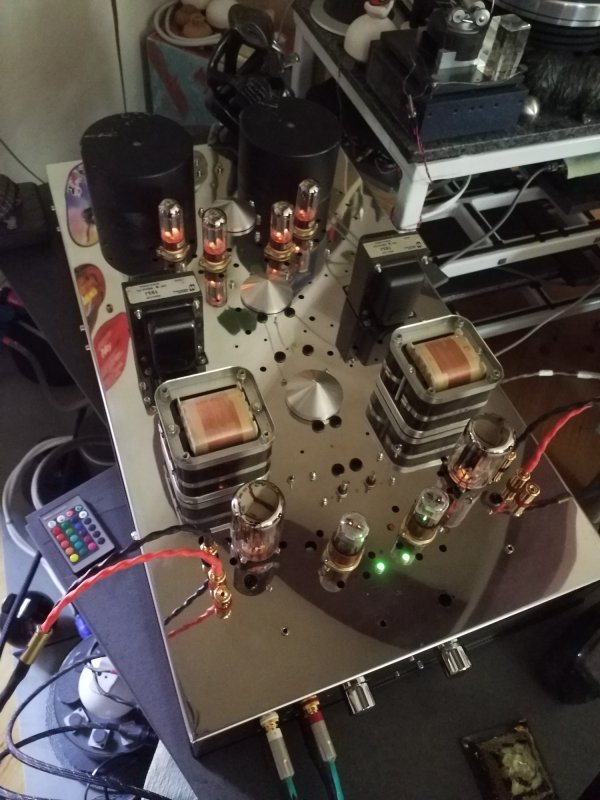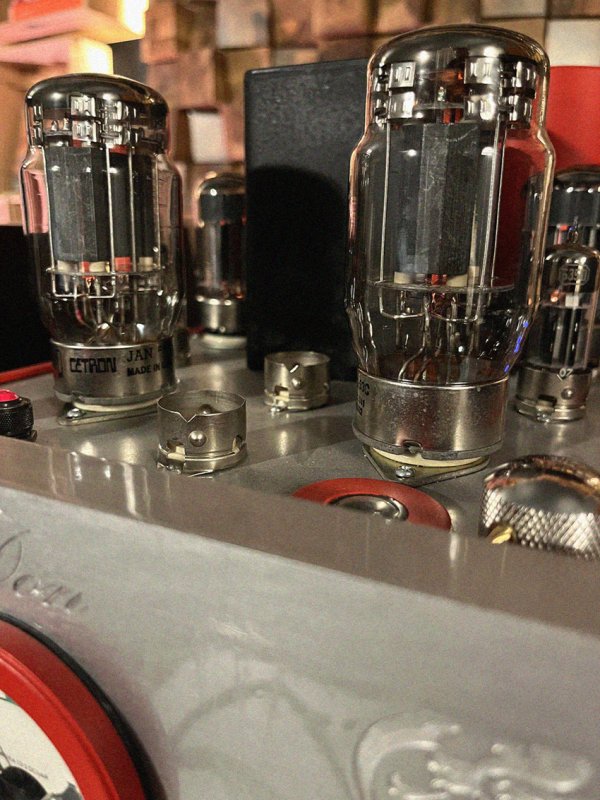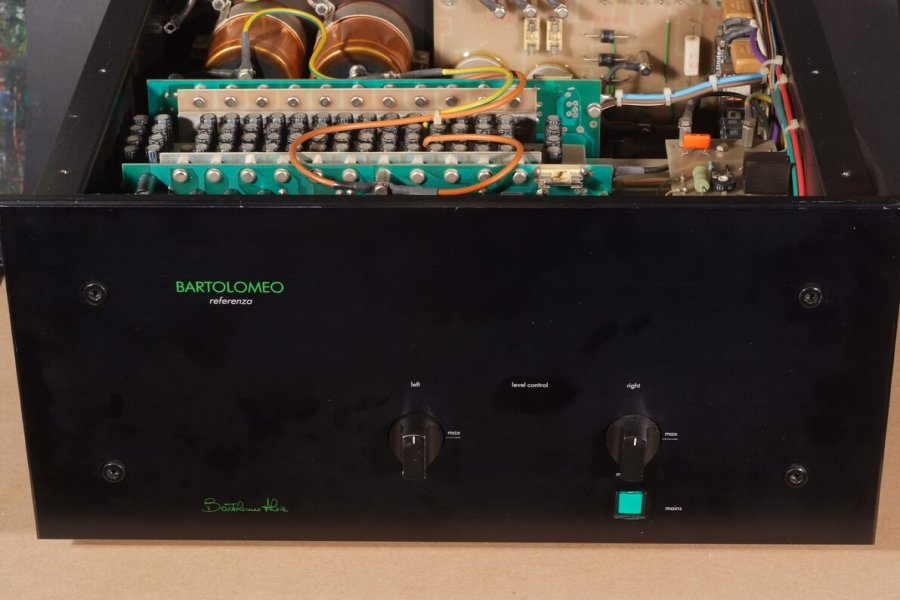Can't recall seeing or hearing of this one before. Has it been mentioned on a few of the WBF threads.The "Last" you buy in your life i promise you
View attachment 138284View attachment 138285
inductive powersupply 90lbs
Your All Time Favorite Preamplifiers?
- Thread starter musicfirst1
- Start date
You are using an out of date browser. It may not display this or other websites correctly.
You should upgrade or use an alternative browser.
You should upgrade or use an alternative browser.
Ah, how many times I’ve told that to myself in the past 40 years I’ve been buying hi fi. But all to vain. There’s always the next thing to get and try. Audiophiles are like chefs. To a world class chef, there’s no such thing as the perfect dish. There’s always the endless quest to make something different. The joy is in the creating. For audiophiles the joy is in tweaking a system.The "Last" you buy in your life i promise you
View attachment 138284View attachment 138285
inductive powersupply 90lbs
definitely not, it's a small company from Italy. I've heard several evolutionary stages of preamps and power amps from this company. In my opinion they were always among the best there is. the "last" preamp is his masterpiece, as are the four-part mono amplifiers. if you ever get the chance to listen to Bartolomeo Aloia, it's worth it.Can't recall seeing or hearing of this one before. Has it been mentioned on a few of the WBF threads.
This is a mono amp: 2 psu+ voltage unit tubes+ power amp class A

I agree with you, you can't know everything that's on the market. Most of the time it's small companies that have surprised me in a positive way. For example AM audio, ångstrom audio or Bartolomeo Aloia.Ah, how many times I’ve told that to myself in the past 40 years I’ve been buying hi fi. But all to vain. There’s always the next thing to get and try. Audiophiles are like chefs. To a world class chef, there’s no such thing as the perfect dish. There’s always the endless quest to make something different. The joy is in the creating. For audiophiles the joy is in tweaking a system.
Interestingly, they all come from Italy.
unfortunately never seen it here in Germany..thanks for the tipit is curious that you know these Italian brands but you missed the best of them all...View attachment 138324
You can read an introductory article about Master Dissanayake here: https://www.quotidianoaudio.it/test...-elettroniche-by-dissanayake/#google_vignettewhat would that be in your opinion?I am curious about.
you can use the translator to read it in your language (maybe German).
I now own, after many years of many extreme hi-fi devices, the top of the range of Dissanayake production, a preamplifier that is at the top of the world of tube types, its performance cannot be catalogued only in the term preamplifier, it is an expansion of the concept of sound reproduction, it is not a question of volume but of energy, it is an infinite reserve at a level impossible even to think of!
Just tomorrow an enthusiast will come to listen to Dissanayake production here at my place. If you ever want to listen to something you are welcome.
Thanks for the link& invitation. If you ever find yourself in the north of germany, you are welcome to come by and listen to my tube builds.You can read an introductory article about Master Dissanayake here: https://www.quotidianoaudio.it/test...-elettroniche-by-dissanayake/#google_vignette
you can use the translator to read it in your language (maybe German).
I now own, after many years of many extreme hi-fi devices, the top of the range of Dissanayake production, a preamplifier that is at the top of the world of tube types, its performance cannot be catalogued only in the term preamplifier, it is an expansion of the concept of sound reproduction, it is not a question of volume but of energy, it is an infinite reserve at a level impossible even to think of!
Just tomorrow an enthusiast will come to listen to Dissanayake production here at my place. If you ever want to listen to something you are welcome.
Exsample nice 6 watt triode amp .

Last edited:
Can you pls share any photos of your preamp and your system? Dissanayake seems interesting device and more information would be appreciated.You can read an introductory article about Master Dissanayake here: https://www.quotidianoaudio.it/test...-elettroniche-by-dissanayake/#google_vignette
you can use the translator to read it in your language (maybe German).
I now own, after many years of many extreme hi-fi devices, the top of the range of Dissanayake production, a preamplifier that is at the top of the world of tube types, its performance cannot be catalogued only in the term preamplifier, it is an expansion of the concept of sound reproduction, it is not a question of volume but of energy, it is an infinite reserve at a level impossible even to think of!
Just tomorrow an enthusiast will come to listen to Dissanayake production here at my place. If you ever want to listen to something you are welcome.
In the weekend I should be able to post pictures of my, just finished, Dissanayake preamp. Not the same league of Giona's, but definitely a great gear too. I can't stop listening to music when I am home...Can you pls share any photos of your preamp and your system? Dissanayake seems interesting device and more information would be appreciated.
Talking about Maestro Sarath Dissanayake is not easy because it would be necessary to tell a story that has lasted about 60 years, yes because the young Dissanayake began to operate hi-fi things already at the age of 7, inside the large shop of his parents. He told me how he built the first battery-powered radios using more than 100 batteries, at 1.5 volts. just as he designed the cinema of his town at only 12 years old! Currently the production has stabilized on custom-made constructions of very high craftsmanship using military avionics and aerospace components selected from three warehouses full of products not for commercial use. The devices are guaranteed for life, all the construction is point to point, not a single electronic board is used. each device from the smallest to the largest of the production is made with a separate power supply. Very important the schemes that are used in its phono line preamplifiers and power amplifiers are proprietary, in the sense that they are not the usual copying of the usual trite and hackneyed schemes!!! We could talk for days, but there is only one thing to do, try one of its devices in your system, whether it is entry level or higher category, they all have a very distinct soul, the Dissanauyake sound, energy, dimensional stability regardless of the room and the electronics are there upstream!Dissanayake seems interesting device and more information would be appreciated.
Very nice setup!!! I will be very happy to come and visit you!!! for the occasion I will bring a new creature of the Master, a very particular pre-line, it could be an initiatory listening!Thanks for the link& invitation. If you ever find yourself in the north of germany, you are welcome to come by and listen to my tube builds.
I don't want to say much about their phono stage preamps, but I've seen many comparisons with the best of the world's production, but none have ever sounded like the Dissanayake!!!


NO WAY! I built that thing in back the 80s as a teenager. It was published on the Suono magazine as a DIY project called 'superfinale' but a commercial version was also made. Very complicated and a real b*tch to get to work properly.what would that be in your opinion?I am curious about.
P.S in my storage room there is a Bartolomeo dacapo+ referenza D 100. Nice devicesView attachment 138326
View attachment 138327
I want to point out one of the many details that distinguishes a Dissanayake product from the rest of the world production, even at the absolute top level and super expensive! The NOS ceramic tube sockets inside have three fins per hole, something impossible for the competition, since such a construction simply does not exist anymore! Dissanayake Audio boasts three warehouses full of aerospace, military and audio grade NOS components from the early 30's onwards...

In a preamp ceramic does not have the advantage it does in a power amp. Ceramic is more resistant to damage due to arcing which is why it gets used in higher Voltage applications such as a higher power tube power amp. I've had to replace non-ceramic sockets on this account in older tube amps since they started arcing internally. Ceramic prevents this and is also helpful moving heat away from the base of the tube which prolongs power tube life.I want to point out one of the many details that distinguishes a Dissanayake product from the rest of the world production, even at the absolute top level and super expensive! The NOS ceramic tube sockets inside have three fins per hole, something impossible for the competition, since such a construction simply does not exist anymore! Dissanayake Audio boasts three warehouses full of aerospace, military and audio grade NOS components from the early 30's onwards...View attachment 138672
But in a preamp situation the Voltages and currents are significantly lower so arcing isn't a concern (there's no need for +500V in a tube preamp...). At this point the ceramic is at a disadvantage to the more common socket materials due to the poorer dielectric properties of ceramic; IOW the socket is a set of capacitances around each tube pin. A plastic socket dielectric will easily outperform ceramic. This can be important if the best performance is desired.
The plating on the socket contacts is pretty important. Counter to what many audiophiles think, the best material is usually tin plate. Tin, like gold, does not corrode easily or quickly. This is why you can buy 70 year old sockets on ebay that solder perfectly well. Tin is harder than silver or gold so won't wear off the contacts with multiple tube insertions. This is valuable to anyone who likes to hear what different tubes can do. Plus the tube pins are also usually tin plated so you don't have dissimilar materials causing a primitive diode effect.
Tin has been used for so long, that it should have whisker status.In a preamp ceramic does not have the advantage it does in a power amp. Ceramic is more resistant to damage due to arcing which is why it gets used in higher Voltage applications such as a higher power tube power amp. I've had to replace non-ceramic sockets on this account in older tube amps since they started arcing internally. Ceramic prevents this and is also helpful moving heat away from the base of the tube which prolongs power tube life.
But in a preamp situation the Voltages and currents are significantly lower so arcing isn't a concern (there's no need for +500V in a tube preamp...). At this point the ceramic is at a disadvantage to the more common socket materials due to the poorer dielectric properties of ceramic; IOW the socket is a set of capacitances around each tube pin. A plastic socket dielectric will easily outperform ceramic. This can be important if the best performance is desired.
The plating on the socket contacts is pretty important. Counter to what many audiophiles think, the best material is usually tin plate. Tin, like gold, does not corrode easily or quickly. This is why you can buy 70 year old sockets on ebay that solder perfectly well. Tin is harder than silver or gold so won't wear off the contacts with multiple tube insertions. This is valuable to anyone who likes to hear what different tubes can do. Plus the tube pins are also usually tin plated so you don't have dissimilar materials causing a primitive diode effect.
Tin has been used for so long, that it should have whisker status.
unfortunately you don't know what you're talking about, the contacts here are three-blades silver-plated bronze that you can only dream of in modern productions. ceramic is essential for this type of preamplifier because the tubes used absorb 5 Ampere of filament each (they absorb much more than a kt170 tube), this preamplifier is unique, it is a device that works in current. Dissanayake who has 60 years of experience has seen every production and construction in the field of tubes applied to audio reproduction.In a preamp ceramic does not have the advantage it does in a power amp. Ceramic is more resistant to damage due to arcing which is why it gets used in higher Voltage applications such as a higher power tube power amp. I've had to replace non-ceramic sockets on this account in older tube amps since they started arcing internally. Ceramic prevents this and is also helpful moving heat away from the base of the tube which prolongs power tube life.
But in a preamp situation the Voltages and currents are significantly lower so arcing isn't a concern (there's no need for +500V in a tube preamp...). At this point the ceramic is at a disadvantage to the more common socket materials due to the poorer dielectric properties of ceramic; IOW the socket is a set of capacitances around each tube pin. A plastic socket dielectric will easily outperform ceramic. This can be important if the best performance is desired.
The plating on the socket contacts is pretty important. Counter to what many audiophiles think, the best material is usually tin plate. Tin, like gold, does not corrode easily or quickly. This is why you can buy 70 year old sockets on ebay that solder perfectly well. Tin is harder than silver or gold so won't wear off the contacts with multiple tube insertions. This is valuable to anyone who likes to hear what different tubes can do. Plus the tube pins are also usually tin plated so you don't have dissimilar materials causing a primitive diode effect.
Similar threads
- Replies
- 22
- Views
- 1K
- Replies
- 1
- Views
- 244
- Replies
- 22
- Views
- 5K
| Steve Williams Site Founder | Site Owner | Administrator | Ron Resnick Site Owner | Administrator | Julian (The Fixer) Website Build | Marketing Managersing |


















